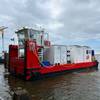Modeling Cranes on Barges with GHS
A new addition to GHS software, the Crane Module, helps naval architects charged with calculating the complicated effects of a crane's performance on barges. Although the Crane Module is useful for modeling any crane, it is especially powerful in modeling large cranes with multiple hooks mounted on a barge or ship.
"Crane manufacturers give a limit to the amount of machine list allowed as the boom lifts and/or rotates," explained Ed Glowacki, owner of Glowacki Engineering, an engineering consulting firm in Florida specializing in naval architecture, "and these cranes are designed to operate on virtually level ground." Glowacki's consulting firm is often called upon to create a modified crane chart for cranes installed on ships and barges – surfaces that are anything but level. These calculations can be incredibly time-consuming, as lifting capacities must account for dynamic loads outside of what is normally included in a crane's design. In the past, these calculations required time-consuming analysis moving back and forth among different software environments. "Now I can develop modified crane charts, keeping an eye on machine list, within one module," added Glowacki.
"The Crane Module was originally developed as a GHS Load Monitor for the U.S. Army Corps of Engineer's Gate Lifter," said Bill Plice, president of Creative Systems, Inc., maker of GHS software. "We created a tool that produces reports showing the results of given lifts including data from a range of swing angles."
Two other optional modules within GHS not only enhance Crane Module's function, they will also expand its capabilities. GHS Load Editor with Windows module (LEw), takes full advantage of the Crane Module's interactive features. When LEw employs the Crane Module, a crane input window appears within the main LEw window for input of hook load, azimuth and elevation angles. A crane data window reports the response in terms of crane trim and list, effective elevation, effective radius and load percentage capacity. This feature is also available in the GHS Load Monitor (GLM) for on board use.
The Multi-Body (MB) optional module allows GHS to handle multiple floating bodies with points of contact between them. In terms of the Crane Module, MB allows for utilization of additional geometry files to enhance the screen display. With the addition of MB, the boom azimuth graphic, for example, responds to the boom azimuth angle. Though the new Crane Module may be used interactively with other optional modules within GHS, they are not required.
(www.ghsport.com)










